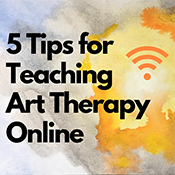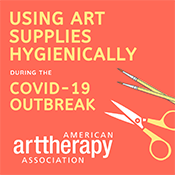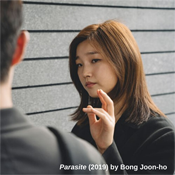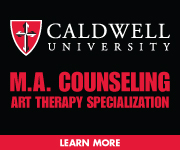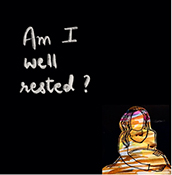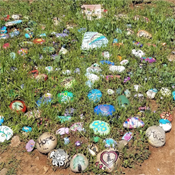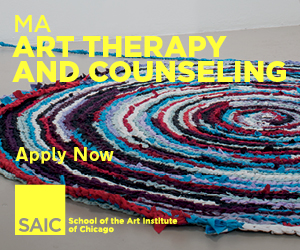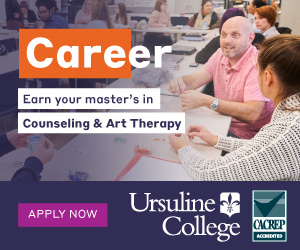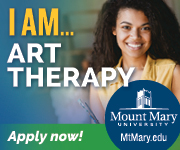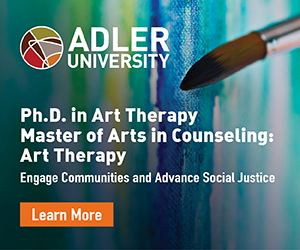 |
|||||||||||||||||||||||||||||||||||||
| Archive | Subscribe | Advertise | arttherapy.org | |||||||||||||||||||||||||||||||||||||
|
Margaret Carlock-Russo, EdD, LCAT, ATR-BC, ATCS AATA President
By AATA National Office Staff
During the coronavirus pandemic, art therapists have been serving as frontline “essential workers,” according to findings from the American Art Therapy Association’s May 2020 online survey. Half (53.1%) of art therapists surveyed said that they are continuing to go to work in person, with many working in psychiatric hospital settings or outpatient mental health clinics. In addition, two thirds (69.9%) reported that they are also working from home at least some of the time during the pandemic, with many having transitioned to teletherapy via video platforms or telephone.
By Trica Zeyher, Art Therapy student at Edinboro University
When I found out that my internship site, Mental Health Partners in Boulder, Colorado, was going to be transitioning to telehealth therapy from face-to-face services due to coronavirus social distancing, I felt prepared from my online graduate experiences. Edinboro University’s online art therapy program provided me with practice to succeed even in these challenging times.
By Andrea Davis, ATR-BC, LPC-AT-S
As we navigate the current coronavirus pandemic, it is a good time to be mindful about art supplies and ways to prevent the spread of illness. The Center for Disease Control (CDC) describes COVID-19 as an airborne illness. Droplets in the air can be breathed in and also land on surfaces including work spaces and art supplies. Protecting clients from harm includes having clean art supplies.
By AATA National Office Staff
Parasite made history during the 2020 Oscars, winning four awards and becoming the first non-English-language film to win best picture, the Academy’s highest honor. This acclaimed playful yet dark satire thriller highlights the opposite spectrums of social class in urban South Korea, taking a microscope to two families whose paths become intertwined when Kim Ki-woo begins tutoring English to the daughter of the wealthy Park family. The clever Kim family devises elaborate schemes to secure employment for each family member without the Parks learning that they are related. The Kims expertly build narratives and forge documents to support claims of their unique qualifications and even carry out plots to have the current house keeper and driver fired as they con their way into various roles within the household.
By Sangeeta Prasad, MA, ATR-BC; Susan Ainlay Anand, MA, ATR-BC, ATCS, LPAT; and Bani Malhotra, MA, ATR-BC
With artistic practices embedded in everyday life in India, the widespread interest in the therapeutic use of art with various populations is not surprising. Several years ago, the three of us met in person for the first time in India. Bani was a graduate student in psychology at University of Delhi and planned to apply to US art therapy graduate programs since none existed in India at that time. From there on, our shared dream of finding ways for people to receive an art therapy education in India has sustained our mentoring and collaborative relationships, which first started on opposite sides of the world!
By Toshiko Kobayashi, LCAT, ATCS, ATR-BC
Origami within the context of an art therapy session can have many uses, including — but not limited to — helping people deal with trauma, practicing mindfulness, and even promoting sensorimotor skills or frustration tolerance. However, the art form has a history that spans back even further than the term “origami” itself. We spoke with art therapist and creator of Expressive Origami Therapy (EOT), Toshiko Kobayashi, LCAT, ATCS, ATR-BC, to get a more in-depth look into the origins of origami, as well as its past and modern role in art therapy practice.
By AATA National Office Staff
As we celebrate our 50th anniversary as an association, we are seeing great momentum in our licensure effort, with a new license signed into law just last month. Over fifty years, we have reached many milestones that illustrate our mission — to advocate for expansion of access to professional art therapists and lead the nation in the advancement of art therapy as a regulated mental health and human services profession. And we look forward to many more achievements as we work to realize our vision — that the services of licensed, culturally proficient art therapists are available to all individuals, families and communities.
By Bani Malhotra, MA, ATR
When my Doctoral Advisor Dr. Girija Kaimal, posed the simple question, “Are you well rested?” during a meeting after the holidays to discuss an online research project started during the pandemic, I hesitantly responded, “I guess?” but asked myself in my head, “Am I really?” I realized that I was prepared to discuss a recent virtual interview that I had conducted and the tasks that I was supposed to complete, but I felt totally thrown off when she was also interested in my personal care.
By Celeste Schexnaydre, BFA, MA, ATR-BC
As someone who lives with a compromised immune system, I have been inside for at least a week longer than the general public. I moved my art therapy private practice inside my home and onto a HIPAA compliant platform immediately after having a cough and wanting to protect my clients as well as myself. This wasn’t a surprise to many of them as some are aware of my health concerns. I have had to re-imagine my career frequently due to these health limitations. As I look back, I recognize that much of my life has been a dress rehearsal for this episode of quarantine, social distancing and a sudden alteration to my art therapy practice. I imagine that most of you can relate in some way. For some of you, maybe even your path to becoming an art therapist prepared you. As art therapists, we recognize the path is one of a pioneer and trailblazer, a different drummer perhaps. But one thing is for sure: it is a path that presents misconception and requires persistence and resilience.
By AATA National Office Staff
This Black History Month, and year round we honor the contributions of African-Americans to the field of art therapy and to the Association. This year, as we celebrate the 365 days of our 50th Anniversary, we reflect on our history and look to the future of the American Art Therapy Association. We are highlighting pioneers, trailblazers and current African-American leaders this month on social media. In case you missed our posts, scroll through to learn highlights on the formative contributions of pioneers Georgette Seabrooke Powell, ATR; Charles Anderson, BFA, ATR-BC; Sarah McGee, PhD; Lucille Durham Venture, PhD, ATR; and Cliff Joseph, ATR.
Top 5 articles in the Journal of The American Art Therapy Association ranked by downloads
By Sojung Park, Hyunjung Lee, Seungeun Kim and Yuri Kim
The globalization of art therapy requires a high level of multicultural competence among art therapists for ethical practice, which includes understanding the traditional materials of the client’s culture. However, the common materials used in art therapy remain mostly Western, which neglects the therapeutic value of art materials from outside the Eurocentric world. This article explores the relations between culture and art materials, using the traditional Eastern materials from the Korean cultural context called Jipilmuk — Ji (paper) pil (brush) muk (Meok, or inkstick). A focus on the philosophical esthetics of East Asia reveals the close connection between materials and culture as well as their therapeutic implications. By Rebecca Bokoch and Noah Hass-Cohen
This program evaluation investigated the Mindfulness and Art Therapy Group Program’s (MATG-P) effectiveness for children’s mental health outcomes and interpersonal impacts. MATG-P provided eight weekly child therapy groups, two conjoint parent-child meetings, and ongoing meetings with teachers. Participants included 83 5- to 12-year-old children, 51 parents, and 22 teachers. Quantitative results from the pretest posttest nonequivalent control group design showed statistically significant decreases in internalizing and externalizing symptoms and significant increases in attention as rated by parents and teachers, as well as significant increases in peer relationship quality and mindful parenting as rated by parents. These results demonstrated the value of a child-centered, integrated art therapy and mindfulness curriculum in schools. By Huma Durrani
This article presents a sensory-based relational art therapy approach (S-BRATA) framework for working with children with autism spectrum disorder (ASD) that explicitly addresses sensory integration dysfunction (SID) and impaired attachment. Developed based on three case studies and rooted in grounded theory methodology, the study resulted in seven themes: (1) sense of safety, (2) working with the child’s sensory profile, (3) art materials as entry point for engagement, (4) attachment formation through mirroring and attunement, (5) flexibility in approach, (6) structure and boundaries, (7) art product not the focus. As a preliminary framework, S-BRATA extends and develops established concepts into a unified model. By Tuesdai Johnson, Sarah P. Deaver and Cheryl Doby-Copeland
This qualitative study addressed the problem of lack of racial and ethnic diversity in American graduate art therapy programs. Seven current art therapy students or recent graduates of color from one predominantly White institution participated in individual semi-structured interviews and a group meeting. Results of thematic analysis yielded four overarching patterns; Courses, Internship, Affective Disruptions, and Differences, from which 10 themes and 14 sub-themes emerged. Narratives and strategies support published best-practices as participants identified limited course content relative to the contributions of pioneers of color, uneven exposure to course content designed to increase racial/cultural self-awareness, and preparation for cross-cultural interactions. By Nancy Couture, Patrick Villeneuve and Sophie Éthier
Alzheimer’s disease (AD) is a threat to the individual and marital integrity of couples as the relationship is called upon to evolve into a caregiver-patient one. In Quebec (Canada), there are currently very few services offered in which these couples can participate together as a couple. In a qualitative multi-case study, five couples had the opportunity to participate in art therapy informed by integrative behavioral couple therapy over 10 meetings held in their homes. The results suggest that art therapy has many positive benefits on these couples, such as providing pleasure, expressing emotions, assessing relational dynamics, and fostering empathy. It was found that art therapy fulfilled five specific functions: play, appease, stimulate, express, and transform.
|
|||||||||||||||||||||||||||||||||||||
|
The AATA's Art Therapy Today includes a digest of the most important news selected for the AATA from thousands of sources. Guest articles may be submitted to info@arttherapy.org. Publication of any guest article is at the sole discretion of the AATA. The opinions expressed and/or contents of guest articles, advertisements, and external links included in any AATA publication do not represent the positions or policies of the AATA. The AATA makes no warrenty or representation concerning the accuracy of such content. |
|||||||||||||||||||||||||||||||||||||
 We, at AATA, are so proud of our members at the end of another challenging year. AATA members have worked through burnout, civil unrest, political turmoil and the second year of a global health crisis — all the while helping their clients through these circumstances and more.
We, at AATA, are so proud of our members at the end of another challenging year. AATA members have worked through burnout, civil unrest, political turmoil and the second year of a global health crisis — all the while helping their clients through these circumstances and more.

